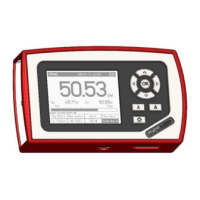6.4 PM100D SCPI Commands
the first response followed by the complete second response. To avoid this, do not
send a query command without reading the response. When you cannot avoid this
situation, send a device clear before sending the second query command.
SCPI Command Terminators
A command string sent to the power/energy meter must terminate with a <new line>
character. The IEEE-488 EOI (end-or-identify) message is interpreted as a <new
line> character and can be used to terminate a command string in place of a <new
line> character. A <carriage return>
followed by a <new line> is also accepted. Command string termination will always
reset the current SCPI command path to the root level.
IEEE-488.2 Common Commands
The IEEE-488.2 standard defines a set of common commands that perform functions
like reset, self-test, and status operations. Common commands always begin with an
asterisk ( * ), are four to five characters in length, and may include one or more
parameters. The command keyword is separated from the first parameter by a blank
space. Use a semicolon ( ; ) to separate multiple commands as shown below:
"*RST; *CLS; *ESE 32; *OPC?"
SCPI Parameter Types
The SCPI language defines several different data formats to be used in program
messages and response messages.
Numeric Parameters Commands that require numeric parameters will accept all
commonly used decimal representations of numbers including optional signs, decimal
points, and scientific notation.
Special values for numeric parameters like MINimum, MAXimum, and DEFault are
also accepted. You can also send engineering unit suffixes with numeric parameters
(e.g., M, K, or u). If only specific numeric values are accepted, the power/energy meter
will automatically round the input numeric parameters. The following command uses
a numeric parameter:
POWer:REFerence {MINimum|MAXimum|DEFault|<numeric_value>[W]}
Discrete Parameters Discrete parameters are used to program settings that have a
limited number of values (like W, DBM). They can have a short form and a long form
just like command keywords. You can mix upper- and lower-case letters. Query
responses will always return the short form in all upper-case letters. The following
command uses discrete parameters:
POW:UNIT {W|DBM}
Boolean Parameters Boolean parameters represent a single binary condition that is
either true or false. For a false condition, the power/energy meter will accept “OFF” or
“0”. For a true condition, the meter will accept “ON” or “1”. When you query a boolean
setting, the instrument will always return “0” or “1”. The following command uses a
boolean parameter:
CURRent:RANGe:AUTO {OFF|0|ON|1}
String Parameters String parameters can contain virtually any set of ASCII
characters. A string must begin and end with matching quotes; either with a single
quote or with a double quote. You can include the quote delimiter as part of the string
by typing it twice without any characters in between. The following command uses a
string parameter:
DIAG:CALString <quoted string>
45

